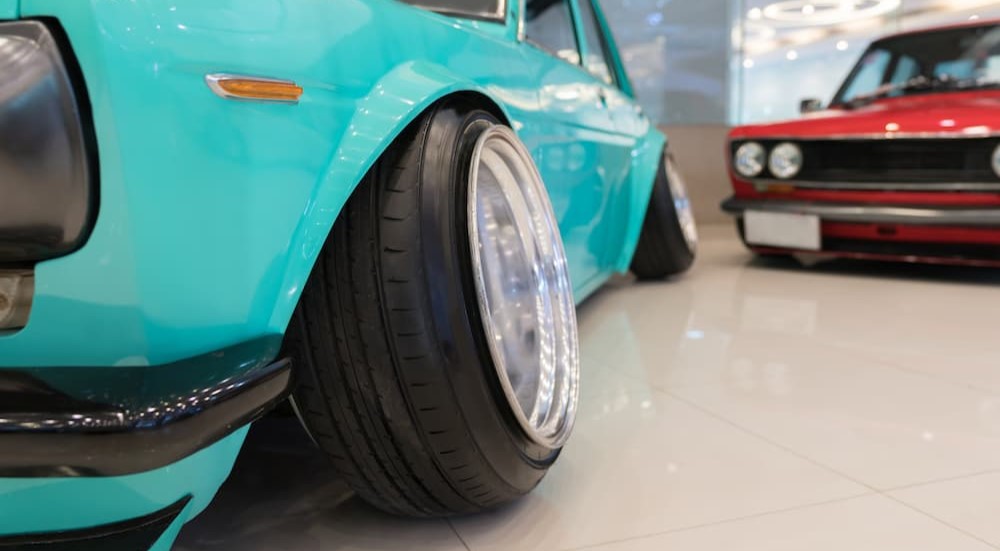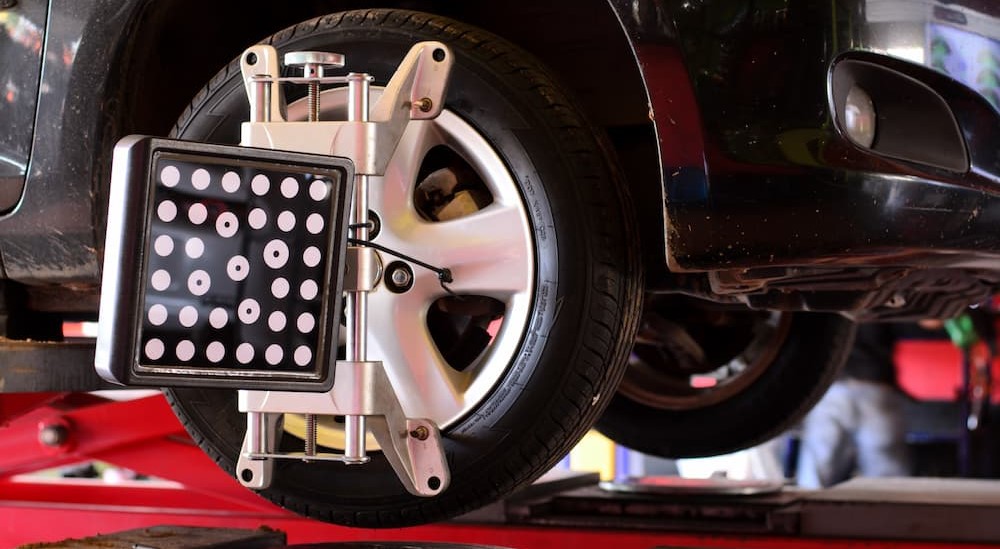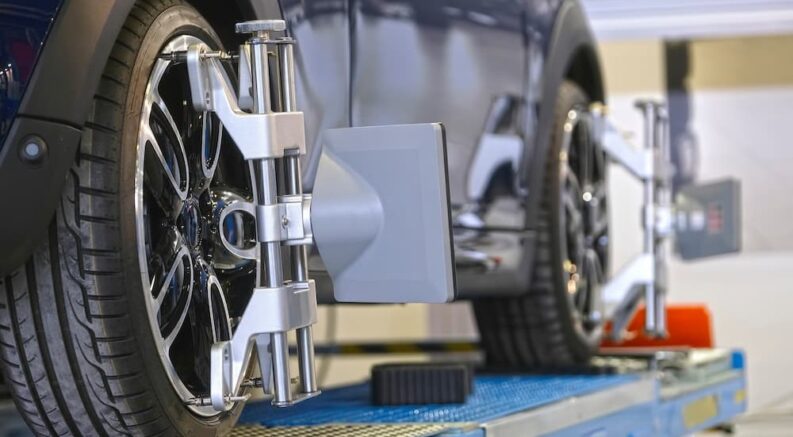Transforming a daily driver into a track car can require a substantial investment. From new shocks and engine tuning to upgraded brakes, tires, and exhaust systems, many fledgling track racers will soon understand why the pros need to plaster their rides with advertisements to help foot the bill. But while it’s easy to focus on some of the more obvious performance mods, an aspiring racer should never discount the importance of a good track alignment, as this is often one of the easiest ways to maximize traction and gain an edge at the track.
Most production vehicles are designed to provide comfort and control on the city streets, country roads, and highways where they spend most of their time. This approach might be fine for everyday driving, but it can put you at a serious disadvantage when you’re going for that checkered flag or trying to achieve a new PR. From adjusting camber, caster, and toe time to deciding between paying a professional or taking the DIY approach, let’s take a closer look at the process and see how an alignment makes you faster at the track.
Camber
Camber is one of the simplest concepts to wrap your mind around when it comes to common alignment adjustments. This term basically describes how the wheels are angled in relation to the vehicle. When an alignment has positive camber, it means the bottom of the tires are angled in toward the vehicle. This setup is commonly found on heavy-duty trucks and tractors and is great if you’re looking to improve a vehicle’s handling and stability, but it’s not a great choice for more dynamic driving situations—and that’s where negative camber comes in.
With negative camber, the top of the wheel is angled in toward the vehicle. This creates a larger contact patch between the tires and the ground, resulting in improved traction and cornering stability—two vital factors in the world of track racing. But too much negative camber can also have a detrimental effect on a car’s driving dynamics. While a modest amount of negative camber can improve cornering stability, going overboard can result in a noticeable decline in straight-line stability.
Braking and acceleration can also be affected, but the biggest downside is accelerated tire wear. Negative camber will cause the inner part of a tire’s tread to wear away a little quicker than normal due to the increased load and contact with the road. Adjusting your camber might be an easy way to improve your racing setup, but you might also want to start saving up for a new set of tires.

Caster
The next factor to consider when crafting the perfect track alignment is caster. This concept is a little more difficult to wrap your head around when compared to camber, but stick with us…
In basic terms, caster is the position of the wheels in relation to the vehicle’s strut mount or upper ball joint. Just imagine a straight line drawn between a wheel’s upper and lower steering pivot points. In a vehicle with a positive caster, this angle slopes toward the driver, which has the effect of basically pushing the wheel forward in the wheel well.
As you might have guessed, negative caster is just the opposite, with the angle sloping away from the driver and causing the wheel to effectively slide backward in the wheel well. Negative caster doesn’t confer any real performance benefits and should generally be avoided as it could cause less responsive steering and increased front-wheel instability. So why would a driver want to mess with their vehicle’s caster?
It all comes down to camber and its effect on cornering ability. Tweaking your alignment towards a more positive caster will actually improve the amount of negative camber, which, in turn, improves traction and cornering ability. Positive caster also creates a unique sort of self-aligning torque that makes the front wheels want to stay pointed forward; this goes a long way in keeping a vehicle nice and centered, especially when subjected to the higher speeds one might encounter at the track.
This description of caster might leave some readers with an obvious question: why bother adjusting caster when you could just adjust camber directly? By adjusting caster, drivers can reap many of the benefits of negative camber without having to make radical adjustments to the latter. A few additional degrees of caster can go a long way, improving a vehicle’s steering and high-speed stability while also enhancing handling.
Drivers will often adjust caster instead of camber as a means of providing the best possible ride for both track and street applications, but taking a subtle approach is usually the best. While a small amount of positive caster—typically between six and eight degrees—can improve negative camber, overdoing it can actually reduce overall traction.
As with camber, your vehicle may only offer small amounts of adjustment. Of course, there are some downsides to messing with your caster. An excess of positive caster can cause an odd, wavy tire wear pattern known as feathering, where the treads are low and smooth on one side and high and sharp on the other. Caster adjustments are also typically limited to rear-wheel drive vehicles, though drivers with front- or all-wheel drive models can invest in adjustment tension rods or arms, offset caster bushings, or offset top mounts to achieve the same effect.
Toe
Finally, there’s toe angle, which describes the degree to which the wheels are angled in or out. Sound complicated? Luckily, there’s a handy avian comparison we can employ to simplify the concept: if you’ve ever heard the term “pigeon-toed,” you should already be able to picture a vehicle with a toe-in alignment. When viewed from above, toe-in wheels will have a smaller gap toward the front of the tire than at the back. Toe-out (which is similar to the concept of being “duck-footed” or “slew-footed”) is just the opposite, with a larger gap toward the front of the wheel than in the back.
Generally speaking, toe-in will improve understeer while toe-out will improve a vehicle’s oversteer. A little toe-in on the front wheels will improve straight-line stability but will make it a little more difficult to turn. Toe-out does just the inverse, reducing overall stability but allowing drivers to turn with ease. So, how does this all play out on the track?
The toe-out approach can make it easier to wrestle a car through the curves, but stability is also an important factor when it comes to safety. Luckily, today’s independent front and rear suspensions allow drivers to enjoy the best of both worlds. In a rear-wheel-drive vehicle, aligning the front wheels with more toe-out and the rear wheels with more toe-in will increase steering responsiveness while keeping the rear end from drifting around the road.
That said, drivers should always take baby steps when messing with their vehicle’s toe angle. While camber and caster are usually described in terms of degrees, alignment experts recommended using much more precise measurements when adjusting toe angle. Even a fraction of an inch can make all the difference, which is why it’s important to go slowly and make very gradual adjustments.
Drivers might even want to replicate the weight—including driver weight and fuel load—that a vehicle will experience on the track while adjusting their toe angle as even these can have a noticeable impact on the overall ride. While adjusting a car’s toe angle is often considered the most important part of the track alignment process, it’s not the right place to start. Toe angle can easily be affected by a vehicle’s camber and caster, which is why these two adjustments should be tackled first.

Professional or DIY?
Adjusting your alignment for the world of track racing isn’t the easiest undertaking, requiring a fair share of experience along with some potentially pricey tools. For this reason, many drivers opt to have their alignment adjusted by a professional. In the case of an everyday commuting vehicle, this might run you between $60 and $80, but the price can quickly shoot up to around $200 if you’re looking for track-ready performance.
In theory, an alignment can be performed in the comfort of your own garage with some string and some number crunching, though there are also tools—including a digital angle finder, toe plates, and alignment kits—that can provide a little more accuracy. If you’re up for a learning experience, feel free to explore these options, but it’ll always be tough to replicate the kind of results you can get from the $50k-plus alignment setups found at your local tuner.
In the end, it all depends on what sort of results you’re looking for and how much you’re willing to invest. If track racing is a relatively new hobby of yours, gaining a little experience with DIY alignment might not be a bad idea. If, on the other hand, you’re looking for instant results or are piloting a particularly pricey vehicle, we’d recommend letting the pros have a go.
An overhauled alignment might not be the flashiest modification, but it can make a big difference when it comes to on-track success. Unless you’ve purchased a purpose-built racer, chances are the stock suspension was designed with everyday driving in mind, not the sort of high-speed antics and cornering one will experience out on the track. By adjusting a suspension’s camber, caster, and toe, it’s easy to enhance some of those qualities that make for a good racer while minimizing those better suited for your daily commute or quiet suburban streets.
It’s also important to consider what type of racing you’ll be doing, what the courses might be like, and the sort of weather conditions you might encounter, as they can all have an effect on how you tweak the alignment. Ultimately, drivers will probably have to learn what sort of alignment works best for them as they gain experience with racing and their vehicle in general. There’s no one-size-fits-all approach when it comes to alignment, but a few small tweaks can have a big impact on performance.

